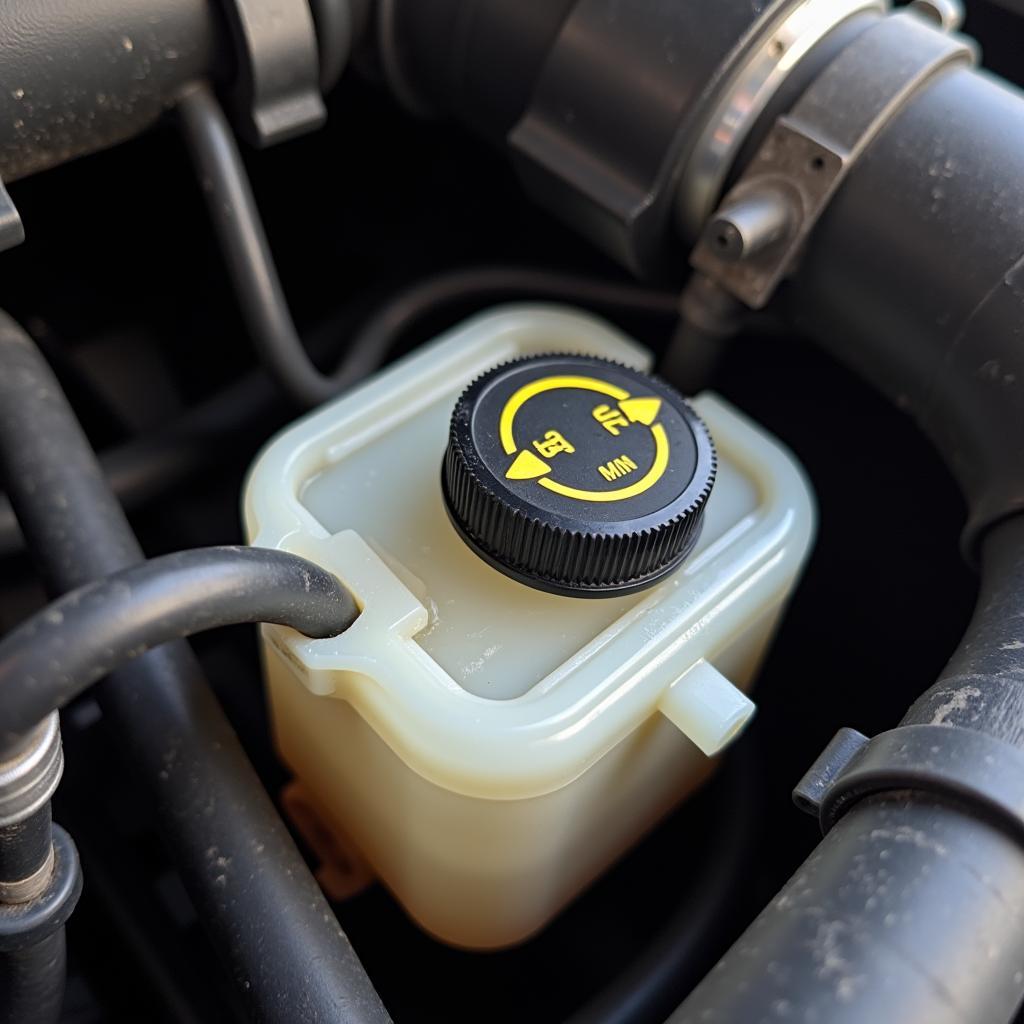A glowing brake warning light on your 1993 Toyota Supra dashboard can be a nerve-wracking experience. It signals a potential issue with your braking system that should never be ignored. While it might seem alarming, understanding the common causes can help you diagnose and potentially fix the problem yourself. Let’s delve into the reasons behind this warning light and explore the solutions to get you back on the road safely.
Common Causes of a 1993 Toyota Supra Brake Warning Light
Several factors can trigger the brake warning light in your 1993 Toyota Supra. Here’s a breakdown of the most common culprits:
1. Low Brake Fluid Level
One of the primary reasons for the brake warning light is low brake fluid. Your Supra, like all hydraulic brake systems, relies on brake fluid to transmit force when you press the pedal. A leak in the system or worn brake pads can cause the fluid level to drop, triggering the warning light.
 1993 Toyota Supra Low Brake Fluid Reservoir
1993 Toyota Supra Low Brake Fluid Reservoir
What to do: Check the brake fluid level in the reservoir. If it’s below the “MIN” mark, add the recommended brake fluid for your Supra. However, simply topping off the fluid won’t solve the problem if there’s a leak. It’s crucial to inspect the brake lines, calipers, and wheel cylinders for any signs of leakage.
2. Worn Brake Pads
Brake pads are your first line of defense when stopping your Supra. As you use your brakes, the friction material on the pads wears down. When they become too thin, it can trigger the brake warning light.
What to do: Inspect your brake pads for wear. If they are nearing the wear indicators or appear significantly thinner than usual, it’s time for a replacement.
3. Faulty Brake Caliper or Wheel Cylinder
The brake calipers and wheel cylinders house the pistons that push the brake pads against the rotors or drums. A stuck or leaking caliper or wheel cylinder can cause uneven braking, dragging brakes, and trigger the warning light.
What to do: Inspect your calipers and wheel cylinders for signs of leaks or sticking pistons. This often requires removing a wheel to get a clear view. If you find a faulty component, rebuilding or replacing it is necessary.
4. ABS Issue
The 1993 Toyota Supra is equipped with an Anti-lock Braking System (ABS). If the ABS module detects a problem, it can trigger the brake warning light. This could be due to a faulty wheel speed sensor, a malfunctioning ABS module, or wiring issues.
What to do: Diagnosing ABS problems typically requires a specialized scanner that can read ABS codes. If you suspect an ABS issue, it’s best to consult a qualified mechanic.
Remote Diagnostics and Software Solutions for Your 1993 Toyota Supra
While some brake issues require hands-on repairs, advancements in automotive technology allow for remote diagnostics and software solutions. As an expert in this field, I can offer the following:
-
Remote Diagnostics: Connect your Supra to a specialized diagnostic tool, and I can remotely access the car’s computer system to read fault codes and analyze data, often pinpointing the root cause of the brake warning light.
-
Software Updates and Programming: Occasionally, software glitches within your Supra’s electronic control unit (ECU) can cause warning lights to illuminate erroneously. Remotely updating or reprogramming the ECU can potentially resolve these issues.
Expert Insight:
“Many car owners underestimate the role software plays in modern vehicles like the 1993 Toyota Supra. A simple software update or reset can sometimes resolve seemingly complex issues.” – John Miller, Automotive Electronics Engineer
Conclusion
Addressing a brake warning light in your 1993 Toyota Supra should be a top priority. By understanding the common causes and possible solutions, you can take the necessary steps to ensure your safety on the road. Remember, while some fixes can be done at home, more complex issues, especially those related to the ABS system, are best handled by professionals with experience in 1993 Toyota Supra brake systems.
